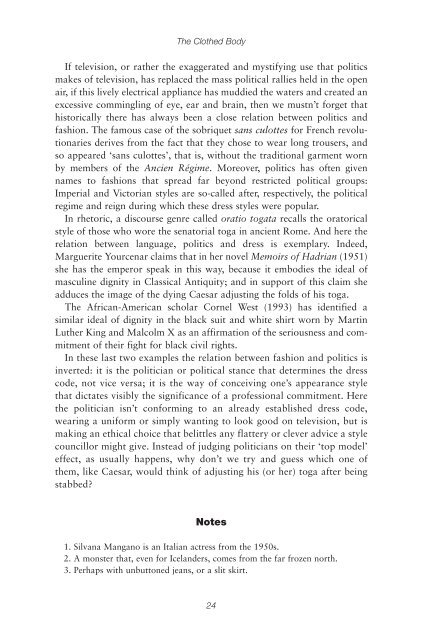You also want an ePaper? Increase the reach of your titles
YUMPU automatically turns print PDFs into web optimized ePapers that Google loves.
<strong>The</strong> <strong>Clothed</strong> <strong>Body</strong><br />
If television, or rather the exaggerated and mystifying use that politics<br />
makes of television, has replaced the mass political rallies held in the open<br />
air, if this lively electrical appliance has muddied the waters and created an<br />
excessive commingling of eye, ear and brain, then we mustn’t forget that<br />
historically there has always been a close relation between politics and<br />
fashion. <strong>The</strong> famous case of the sobriquet sans culottes for French revolutionaries<br />
derives from the fact that they chose to wear long trousers, and<br />
so appeared ‘sans culottes’, that is, without the traditional garment worn<br />
by members of the Ancien Régime. Moreover, politics has often given<br />
names to fashions that spread far beyond restricted political groups:<br />
Imperial and Victorian styles are so-called after, respectively, the political<br />
regime and reign during which these dress styles were popular.<br />
In rhetoric, a discourse genre called oratio togata recalls the oratorical<br />
style of those who wore the senatorial toga in ancient Rome. And here the<br />
relation between language, politics and dress is exemplary. Indeed,<br />
Marguerite Yourcenar claims that in her novel Memoirs of Hadrian (1951)<br />
she has the emperor speak in this way, because it embodies the ideal of<br />
masculine dignity in Classical Antiquity; and in support of this claim she<br />
adduces the image of the dying Caesar adjusting the folds of his toga.<br />
<strong>The</strong> African-American scholar Cornel West (1993) has identified a<br />
similar ideal of dignity in the black suit and white shirt worn by Martin<br />
Luther King and Malcolm X as an affirmation of the seriousness and commitment<br />
of their fight for black civil rights.<br />
In these last two examples the relation between fashion and politics is<br />
inverted: it is the politician or political stance that determines the dress<br />
code, not vice versa; it is the way of conceiving one’s appearance style<br />
that dictates visibly the significance of a professional commitment. Here<br />
the politician isn’t conforming to an already established dress code,<br />
wearing a uniform or simply wanting to look good on television, but is<br />
making an ethical choice that belittles any flattery or clever advice a style<br />
councillor might give. Instead of judging politicians on their ‘top model’<br />
effect, as usually happens, why don’t we try and guess which one of<br />
them, like Caesar, would think of adjusting his (or her) toga after being<br />
stabbed?<br />
Notes<br />
1. Silvana Mangano is an Italian actress from the 1950s.<br />
2. A monster that, even for Icelanders, comes from the far frozen north.<br />
3. Perhaps with unbuttoned jeans, or a slit skirt.<br />
24

















